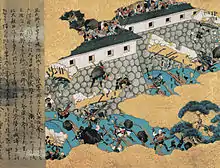| Siege of Akasaka Castle | |||||||||
|---|---|---|---|---|---|---|---|---|---|
| Part of The Genkō War | |||||||||
 | |||||||||
| |||||||||
| Belligerents | |||||||||
|
|
| ||||||||
| Commanders and leaders | |||||||||
|
Kusunoki Masashige Kusunoki Shichiro | Hōjō Sadatadashi | ||||||||
| Strength | |||||||||
| 500[1] | 10,000[2] | ||||||||
| Casualties and losses | |||||||||
| 1000 (est.) | |||||||||
The siege of Akasaka was one of the earlier battles of the Genkō War between the figurehead Emperor Godaigo and the largely Hōjō controlled Kamakura shogunate during the final years of the Kamakura period in Japan. The battle in question was fought at Shimo Akasaka-jō (下赤坂城), or (English: Lower Akasaka fortress), a fortress built upon Mount Yoshino near modern-day Osaka in the former Kawachi Province in Osaka Prefecture.[3]
Background
For most of Japan's history the Emperor was a powerless figurehead while real power rested in the Shogunate, and this was no different for Emperor Godaigo who was overshadowed by the Kamakura Shogunate. But in 1324, in the dying years of the Kamakura period, the Emperor plotted to overthrow the Shogunate but his plan was discovered. Undeterred, he tried again seven years later but was once again discovered due to the treachery of Fujiwara Sadafusa, Godaigo's trusted adviser. Realizing that he was at the end of his rope, the Emperor fled from Kyoto for Kasagi, and was besieged there by Kamakura Shogunate troops (Gokaido would survive the siege but would be banished to the Isles of Oki). Meanwhile, Kusunoki Masashige and Kusunoki Shichiro, two brothers who had sworn their allegiance to the Emperor, were gathering their forces at Shimo Akasaka, a fortress built upon Mount Yoshino, and were joined there by the Emperor's son, Prince Moriyoshi.[4] As 200-300,000 Kamakura Shogunate soldiers arrived to besiege the fortress in November, Akasaka was garrisoned by 200 samurai inside the fort (5,850 square feet (543 m2) palisade protected by 20-30 wooden towers) under Masashige while another 300 samurai waited on a nearby hill under Kusunoki Shichiro's command.[1][5]
Battle
As soon as the battle started, Masashige set to work, inflicting heavy casualties upon the besiegers; his ingenuity in the battle was highly praised by sources ("schemes were as ingenious as if they had sprung from the brain of Ch'en-p'ing or Chan-kuo Liang."),[2] but his craftiness could not save him and his army from defeat when the Shogunate army cut off his water supply.[4] Masashige proceeded to build a second castle, Kami-Akasaka Castle or Kami Akasaka-jō (上赤坂城), (English: Upper Akasaka fortress). This too was besieged, and fell, in March 1333.[4]: 13–14 [5]: 174
During the initial assault by the Kamakura force, Masashige used skilled archers to kill or wound many before they retreated hastily to make camp for a longer siege. Kusunoki Shichiro picked this time to attack the camp with his horsemen from two sides, and was soon joined by more cavalry from the castle gates. The horsemen "broke through the enemy lines from every direction, cutting them down on all sides and so astounding the shogunate warriors that they could not form ranks."[2]: 118–119
In another assault, the Shogunate soldiers started scaling the outer wall, deceived by the silence from within. Unbeknownst to the attackers, they were scaling a fake wall which Masashige signaled to be collapsed. As the Kamakura troops hit the ground, Masashige's force subjected them to logs and stones hurled at them from with in the fortress, inflicting grievous harm.[2]: 120 In another instance, the attackers tried to grapnel the remaining wall, only to have boiling hot water poured on them by Masashige's men.[2]: 120
Three weeks into the siege, the Imperial troops met the one foe they couldn't outsmart: starvation. In an attempt to finally break the siege, Masashige devised a plan in which his men disguised themselves as Shogunate soldiers and left the bodies of the slain combatants in the fort in a large pile of kindling. Thus disguised, Masashige's men were able to slip through the defenses. Once free, one man left behind lit the bonfire and the castle, deceiving the Kamakura soldiers into thinking they had committed suicide.[2]: 121 Despite the apocryphal, the siege ended in Hōjō victory when Masashige and his men were cut off from water.[6]
When Masashige and Moriyoshi escaped the first fortress, Masashige contacted the local merchants he had connections with and managed to raise a new army with the funds provided to him by them. After retaking Lower Akasaka, he built Kami-Akasaka upon a small plateau surrounded on three sides by a low valley. Unfortunately for Masashige, the Shogunate forces returned, besieged and defeated him again, and burned his fortress to the ground as well.[7] However, he again escaped, this time fleeing to Chihaya Castle, Kami-Akasaka was razed.
References
Bibliography
- De Lange, William (2021). An Encyclopedia of Japanese Castles. Groningen: Toyo Press. pp. 600 pages. ISBN 978-9492722300.
- Morris, Ivan (1975). The Nobility of Failure. Holt, Rinehart and Winston. ISBN 9780030108112.
- Sansom, George (1961). A History of Japan, 1334–1615. Stanford University Press. ISBN 0804705259.
- Sato, Hiroaki (1995). Legends of the Samurai. Overlook Duckworth. ISBN 9781590207307.
- Turnbull, Stephen (1998). The Samurai Sourcebook. Cassell & Co. ISBN 1-85409-523-4.
- Turnbull, Stephen (1977). The Samurai, A Military History. MacMillan Publishing Co., Inc. ISBN 0026205408.
Notes
- 1 2 Turnbull, Stephen (1977). The Samurai, A Military History. MacMillan Publishing Co., Inc. p. 97. ISBN 0026205408.
- 1 2 3 4 5 6 Morris, Ivan (1975). The Nobility of Failure. Holt, Rinehart and Winston. p. 118. ISBN 9780030108112.
- ↑ Nussbaum, Louis-Frédéric. (2005). "Kawachi" in Japan Encyclopedia, p. 496, p. 496, at Google Books.
- 1 2 3 Sansom, George (1961). A History of Japan, 1334-1615. Stanford University Press. pp. 7–11. ISBN 0804705259.
- 1 2 Sato, Hiroaki (1995). Legends of the Samurai. Overlook Duckworth. pp. 160–165. ISBN 9781590207307.
- ↑ Turnbull, Stephen (1998). The Samurai Sourcebook. Cassell & Co. p. 206. ISBN 1-85409-523-4.
- ↑ "Kamiakasaka Castle". Retrieved 23 September 2016.